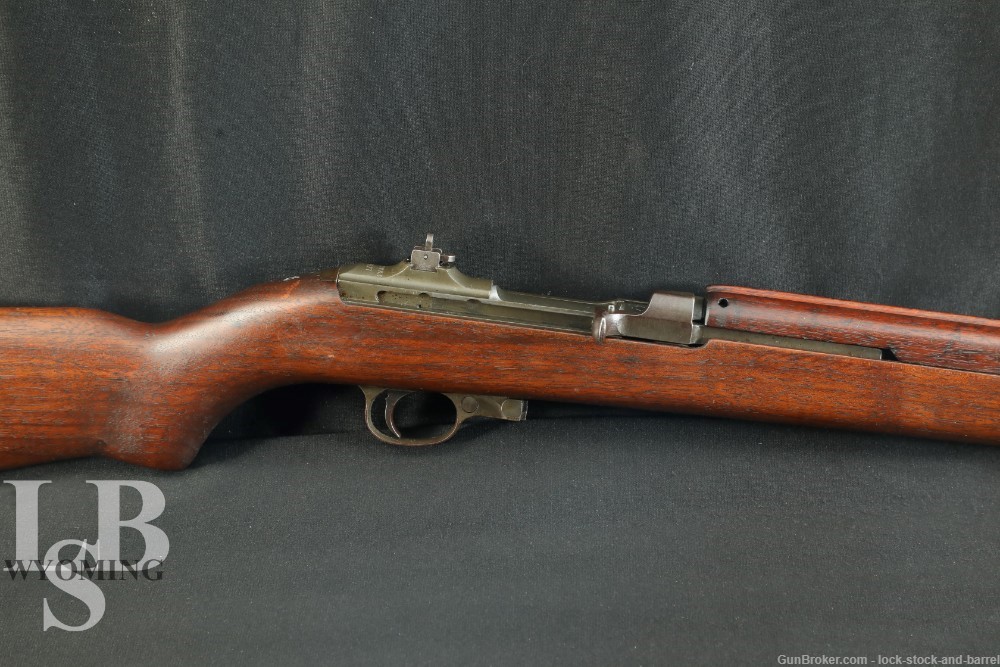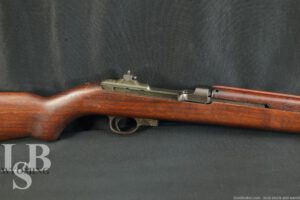
Quality Hardware & Machine M1 Carbine .30 Cal 18” Semi-auto Rifle 1943 C&R
SOLD FOR: $1,930.00
WOA#: WY240406WM012
Make: Quality Hardware & Machine Co.
Model: M1 Carbine
Serial Number: 1565227
Year of Manufacture: June 1943
Caliber: .30 Carbine
Action Type: Semi-Automatic
Markings:
The top-rear of the receiver is marked “QUALITY H.M.C.”, and “1565227”.
The top-front of the receiver is marked “U.S. CARBINE”, “CAL .30 M1”.
The barrel is marked with a ‘P”, “ROCK-OLA 1-43”, and “ROCK-OLA” on the right side.
The front barrel band is unmarked.
The front sight is marked “N”
The rear sight is marked “GE-Q” and “S”.
The magazine release button is unmarked.
The hammer is marked “LT-Q”
The trigger group is marked “Q-NL”
The right side of the stock is marked with a faint ordinance wheel and inside the sling cut is marked “RMC” for Rock-Ola music company.
Barrel Length: 18″
Sights / Optics: The front sight is a fixed blade with protective ears. The rear sight is an early style L type aperture sight dovetailed to the receiver.
Stock Configuration & Condition: The stock is an early “I” cut High Wood stock, with a type 1 barrel band, a Type 1 two rivet handguard and a checkered metal butt plate. This rifle also has the early cross bolt safety. The LOP measures about 13.25” from the front of the trigger to the back of the stock. The stock has very minor compressions and scratches throughout. The buttplate has lost some of its finish, has begun to turn brown with patina and has a few small patches of surface rust. The barrel band has some oxidation present. There are no chips or cracks. Overall the stock is in Good to Very Good condition for C&R.
Magazine Quantity & Condition: None.
Type of Finish: Blued, Parkerized, Phosphate
Finish Originality: Original
Bore Condition: The bore is bright and the rifling is visible. There is little to no visible erosion in the bore although there is a patch of pitting in the 2 o’clock position about ½ an inch back from the muzzle. In this writer’s opinion the bore rates 7/10.
Overall Condition: This rifle retains about 85% of its metal finish. The barrel has some very light surface scratches, the receiver and bolt show some operational wear on the friction surfaces, the trigger guard has lost its finish and turned brown with patina as has the changing handle. The screw heads are sharp and the markings are mostly clear. Overall this rifle is in Good to Very Good Condition for C&R.
Mechanics: The action functions correctly. We did not fire this rifle. As with all used firearms, a thorough cleaning may be necessary to meet your maintenance requirements.
Box, Paperwork & Accessories: None.
Our Assessment: During the early stages of World War II, the U.S. military recognized the need for a lightweight rifle that would bridge the gap between the heavy and cumbersome M1 Garand rifle and the standard issue sidearm, the M1911 pistol. The goal was to provide troops with a compact and easy-to-handle firearm that offered more firepower than a pistol but was lighter and more maneuverable than a full-size rifle.
In 1941, the U.S. Army’s Ordnance Department contracted with various manufacturers, including Winchester, IBM, and General Motors’ Inland Division, and Quality Hardware and Machine to develop and produce the M1 Carbine. The rifle was designed by a team led by firearms designer David Williams, who drew inspiration from the successful M1 Garand and the short-recoil action of the M1 Thompson submachine gun. The M1 Carbine featured a gas-operated, semi-automatic action and fired a .30 caliber cartridge known as the .30 Carbine. The cartridge, while less powerful than the standard .30-06 ammunition used in the M1 Garand, offered greater capacity and reduced recoil, making it more controllable and well-suited for short to medium-range engagements.
The M1 Carbine saw widespread use in World War II, becoming a staple firearm for American troops. It was praised for its reliability, ease of use, and versatility. The rifle was not only issued to U.S. forces but also provided to allied nations through various lend-lease programs.
After World War II, the M1 Carbine continued to serve in the Korean War and saw limited use in subsequent conflicts. It also became popular among civilian shooters and collectors due to its historical significance and manageable recoil. The M1 Carbine played a significant role in U.S. military history, offering a lightweight and reliable firearm that filled a niche between pistols and full-size rifles. Its compact design, firepower, and ease of use made it a favored weapon among soldiers in various roles and contributed to its enduring legacy. On a personal note, I always love seeing Quality HMC M1 carbines. Their heavy use of Rock-Ola Music company parts, Rock-Ola being famous for making Juke Boxes, is simply an interesting statement about the unity and vision of Americans in the WWII era. Please see our photos and best of luck with your bidding!!!-R.L.

